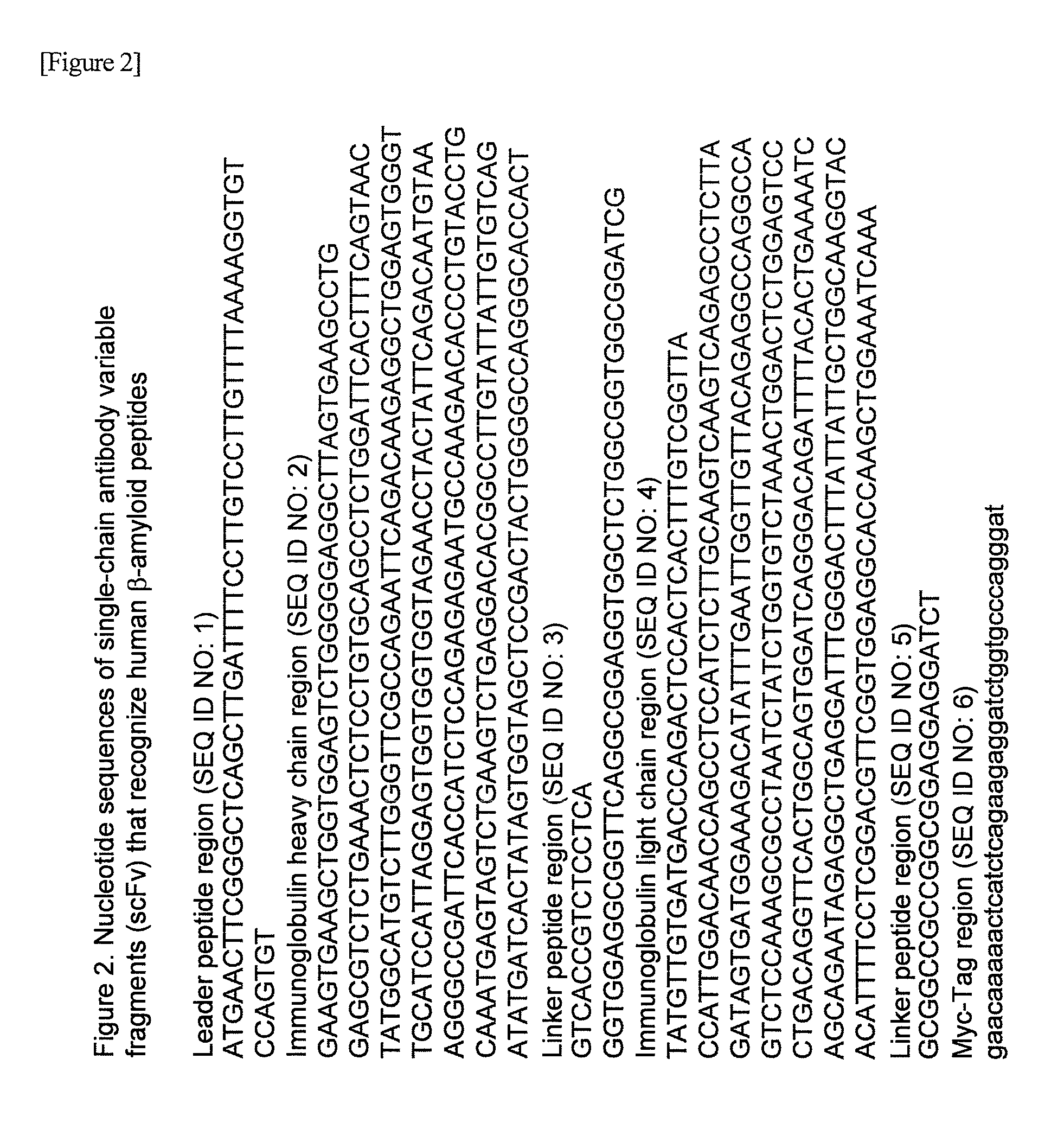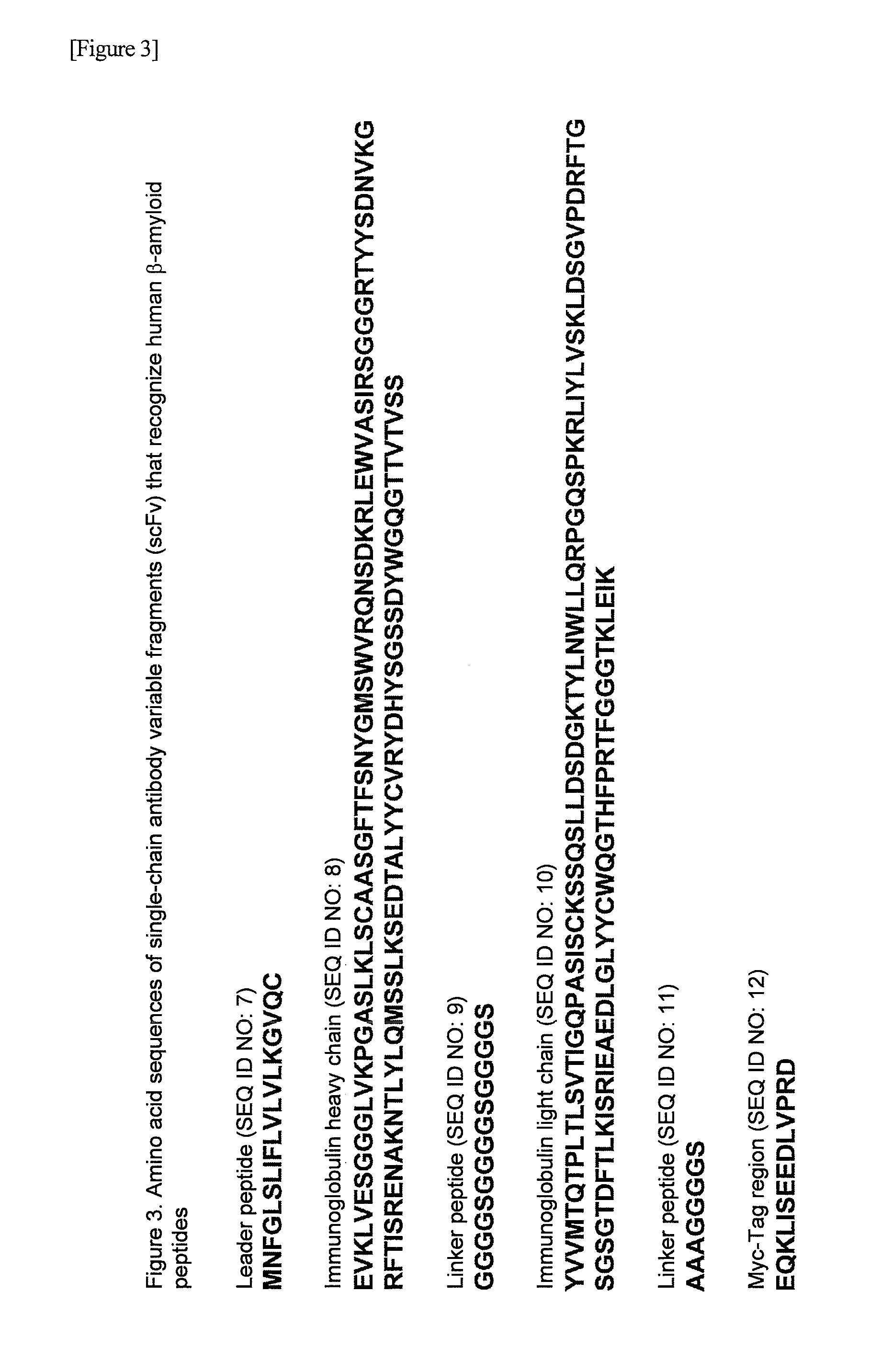Method for producing cell medicine
- Summary
- Abstract
- Description
- Claims
- Application Information
AI Technical Summary
Benefits of technology
Problems solved by technology
Method used
Image
Examples
example 1
Production of Single-Chain Antibody (ScFV) Expression Vector that Recognizes Human β-Amyloid Peptide
(1) Production of Variable Region Nucleotide Sequences
[0064]Based on the nucleotide sequences of the variable regions of the heavy chain and light chain of a monoclonal antibody recognizing a human β-amyloid peptide (mouse hybridoma clone: 3D6) (described in Patent document 2007-0238154), the nucleotide sequence of a single-chain antibody variable region recognizing a β-amyloid peptide was designed. FIG. 2 shows the nucleotide sequence thereof, and FIG. 3 shows the amino acid sequence of a protein encoded by this nucleotide sequence. Based on the designed nucleotide sequence, GeneScript Corporation (New Jersey, U.S.A.) was asked to artificially synthesize DNA. Thereafter, the synthesized DNA was inserted into a plasmid vector.
(2) Production of Immunoglobulin (Mouse IGG2a) Fc Portion and Mouse Fc Receptor (FcγRI) Trans-Cell Membrane-Cytoplasm Site
[0065]Using cDNA derived from RNA extra...
example 2
Production and Culture of Human Induced Pluripotent Stem Cells
[0068]Using a lentivirus vector, an expression vector containing human Oct3 / 4, Sox2, Klf4 and c-Myc was introduced into fibroblasts derived from the skin tissues of the abdominal portion of a healthy subject, so as to produce human induced pluripotent stem cells.
[0069]Specifically, a skin section was collected from a human abdominal portion, and it was then cultured in a culture solution (DMEM / 10% bovine serum) in a cell culture plate. From 1 week after initiation of the culture, migration of fibroblasts from the skin section and the proliferation thereof were observed. Thus, using trypsin and EDTA, the fibroblasts were appropriately recovered and preserved in a frozen state.
[0070]The cDNAs of human Oct3 / 4, Sox2, Klf4 and c-Myc serving as reprogramming factors were each produced by the PCR method, using cDNA derived from human ES cells (KhES-1) or genomic DNA as a template. The thus produced cDNAs were each inserted into ...
example 3
Introduction of Single-Chain Antibody Expression Vector into Human iPS Cells
[0077]The DNA of the single-chain antibody (scFv) expression vector (plasmid vector) produced in Example 1 was extracted from Escherichia coli according to an alkaline-SDS method, and it was then purified with an anion exchange column (Qiagen Plasmid Maxi kit; manufactured by Qiagen). The thus purified DNA was cleaved with a restriction enzyme PvuI to prepare linear DNA. Moreover, the linear DNA was purified using phenol and chloroform, and it was then recovered by isopropanol precipitation. Thereafter, the recovered DNA was washed with 70% ethanol, and it was then dissolved in a phosphate buffered saline (PBS).
[0078]The human iPS cells that had been subjected to the maintenance culture (the cell clones produced by the route shown in FIG. 4B) were recovered from the culture vessel using trypsin-EDTA (025% trypsin / 1 mM EDTA), and they were then suspended in a DMEM solution (1×107 cells / 0.4 ml). The suspension...
PUM
| Property | Measurement | Unit |
|---|---|---|
| Electrical resistance | aaaaa | aaaaa |
Abstract
Description
Claims
Application Information
 Login to View More
Login to View More - R&D
- Intellectual Property
- Life Sciences
- Materials
- Tech Scout
- Unparalleled Data Quality
- Higher Quality Content
- 60% Fewer Hallucinations
Browse by: Latest US Patents, China's latest patents, Technical Efficacy Thesaurus, Application Domain, Technology Topic, Popular Technical Reports.
© 2025 PatSnap. All rights reserved.Legal|Privacy policy|Modern Slavery Act Transparency Statement|Sitemap|About US| Contact US: help@patsnap.com



